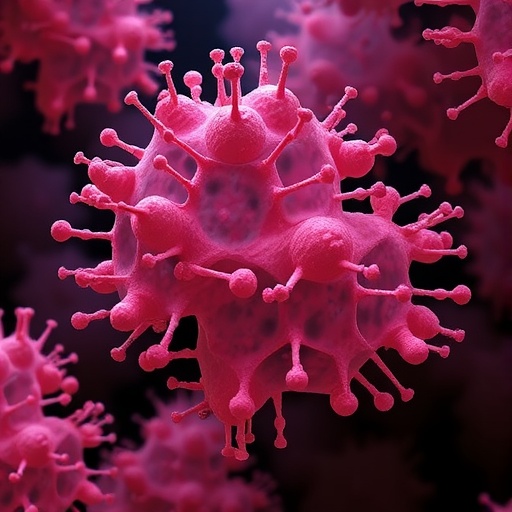In a groundbreaking study that could redefine our understanding of skin infections, researchers have uncovered a novel mechanism by which the notorious bacterium Staphylococcus aureus incurs damage to human keratinocytes, the predominant cell type in the epidermis. Through intricate molecular analyses and sophisticated imaging, the team has demonstrated that this pathogen incites a form of programmed cell death known as pyroptosis via an unexpected mediator: Gasdermin A. This discovery not only elucidates a critical aspect of the skin’s immune response but also opens potential new avenues for therapeutic intervention in bacterial skin infections notoriously difficult to treat.
The implications of this research are particularly significant given the global health burden posed by Staphylococcus aureus, a common pathogen responsible for a wide range of conditions, from minor skin infections to life-threatening diseases such as sepsis and pneumonia. Historically, attention has been focused on the bacterium’s production of toxins that disrupt host cell membranes or trigger canonical inflammatory pathways. However, this new study pivots from traditional paradigms by investigating the direct interactions between S. aureus and keratinocytes, specifically how the pathogen’s presence activates intrinsic cell death programs that can exacerbate tissue damage.
Central to this research is the gasdermin family of proteins, which have emerged as pivotal executors of pyroptosis — a highly inflammatory form of lytic cell death. While most pyroptosis studies to date have highlighted Gasdermin D as the key player, the researchers found that in keratinocytes, Gasdermin A is the primary effector driving the pyroptotic response following S. aureus infection. This delineation of Gasdermin A’s unique role contributes to a nuanced understanding of host-pathogen interactions that may be cell-type specific, highlighting the importance of context in immunological responses.
Using advanced genetic manipulation tools, the research team engineered keratinocyte cultures deficient in Gasdermin A to evaluate the exact contribution of this protein to the observed pyroptotic phenomena. The results were striking: cells lacking Gasdermin A showed a marked reduction in pyroptosis, as quantified by both cell viability assays and measurements of lactate dehydrogenase release, a marker of membrane rupture. These findings strongly support a causal relationship and reveal the indispensability of Gasdermin A in the execution of pyroptosis in response to S. aureus challenge.
Further mechanistic exploration unveiled that the activation cascade begins with the detection of bacterial components by pattern recognition receptors on keratinocytes, leading to the assembly of inflammasome complexes. These multi-protein platforms subsequently activate caspases that cleave Gasdermin A, facilitating the formation of membrane pores that culminate in pyroptosis. Importantly, this stepwise elucidation establishes a direct molecular pathway from bacterial recognition to cell death, clarifying previously ambiguous mechanisms that account for epidermal damage during infection.
Additionally, the spatial distribution of Gasdermin A during infection was carefully mapped using high-resolution microscopy, revealing its translocation to the plasma membrane prior to keratinocyte lysis. This observation provides compelling visual evidence for Gasdermin A’s role in pore formation, complementing biochemical data. Moreover, quantitative proteomic approaches confirmed that the expression levels of Gasdermin A itself are upregulated in response to S. aureus exposure, suggesting an inducible, dynamic regulation of this protein within the epidermal context.
The researchers also explored the inflammatory aftermath of pyroptosis mediated by Gasdermin A, finding that dying keratinocytes release distinct alarmins and cytokines that exacerbate local inflammation. This inflammatory milieu can amplify tissue damage but also serves to alert neighboring immune cells, orchestrating an integrated defense response. Understanding this balance between protective versus pathological inflammation is critical for designing therapeutic strategies that mitigate tissue damage without compromising bacterial clearance.
Intriguingly, comparative studies demonstrated that other skin pathogens do not induce Gasdermin A-dependent pyroptosis to the same extent, underscoring a degree of pathogen specificity in keratinocyte responses. This specificity hints at evolved immunological adaptations tailored to the prevailing microbiological environment of the skin, suggesting that Gasdermin A’s function is finely tuned to particular threats like S. aureus.
Beyond in vitro systems, the team extended their investigations to in vivo models, showing that mice deficient in Gasdermin A exhibited reduced keratinocyte death and decreased inflammation following S. aureus skin infections. These animal experiments validate the clinical relevance of their findings and suggest potential translational applications. For clinicians, the prospect of modulating Gasdermin A activity could represent a novel therapeutic target to attenuate deleterious inflammatory responses in bacterial skin infections, thereby improving patient outcomes.
The study also raises provocative questions about host-pathogen co-evolution, especially how pathogens like S. aureus may manipulate pyroptotic pathways to their advantage, destroying keratinocytes to breach skin barriers and promote colonization. Conversely, the host harnesses these pathways to limit infection spread, highlighting a molecular arms race at the cellular level. Future research will be critical to unravel whether selective inhibition of Gasdermin A could blunt harmful pyroptosis without impairing beneficial antimicrobial immunity.
In terms of broader impact, these findings echo across multiple disciplines, from microbiology and immunology to dermatology. Given that skin infections are among the most common infectious diseases worldwide and often lead to severe complications when complicated by antibiotic resistance, new mechanistic insights like those offered by this study are urgently needed. They challenge old dogmas and encourage innovative thinking regarding cell death pathways as therapeutic leverage points.
Moreover, the discovery shines a spotlight on the gasdermin protein family, whose members have only recently been appreciated for their roles beyond classical inflammatory cascades. This research, therefore, expands the biological repertoire of Gasdermin A, positioning it as a critical factor in epidermal defense. It also hints at broader roles for Gasdermin A in other epithelial tissues and diseases involving pyroptotic mechanisms, opening exciting frontiers for future exploration.
This work was achieved through a multidisciplinary collaboration, integrating cutting-edge genetic, proteomic, and imaging technologies to paint a comprehensive picture of keratinocyte pyroptosis during S. aureus infection. The precision of these techniques underscores how modern biomedical research can unravel complex cellular interactions, with promising implications for patient care.
In conclusion, the identification of Gasdermin A as a key mediator in keratinocyte pyroptosis induced by Staphylococcus aureus marks a significant milestone in infectious disease research. By delineating the molecular events that drive inflammatory cell death in the skin, this study not only deepens our understanding of host defense mechanisms but also signals new horizons for therapeutic innovation. As antibiotic resistance threatens to undermine current treatment paradigms, harnessing cell death pathways such as Gasdermin A-dependent pyroptosis could become an essential strategy in the fight against stubborn skin infections.
Subject of Research: Mechanisms of keratinocyte pyroptosis induced by Staphylococcus aureus infection.
Article Title: Staphylococcus aureus induces Gasdermin A-dependent keratinocyte pyroptosis.
Article References:
LaRock, D.L., Sherman, J.D., Qu, C. et al. Staphylococcus aureus induces Gasdermin A-dependent keratinocyte pyroptosis. Nat Commun 16, 10570 (2025). https://doi.org/10.1038/s41467-025-65674-3
Image Credits: AI Generated
DOI: https://doi.org/10.1038/s41467-025-65674-3
Tags: bacterial infection immune responseepidermis cell damageGasdermin A role in cell deathglobal health impact of Staphylococcus aureusinflammatory pathways in skin infectionsintrinsic cell death programs in keratinocyteskeratinocyte pyroptosis mechanismmolecular analysis of S. aureusnovel mechanisms of bacterial pathogenesisprogrammed cell death in skin cellsStaphylococcus aureus skin infectionstherapeutic interventions for skin infections





